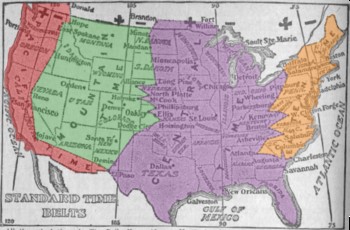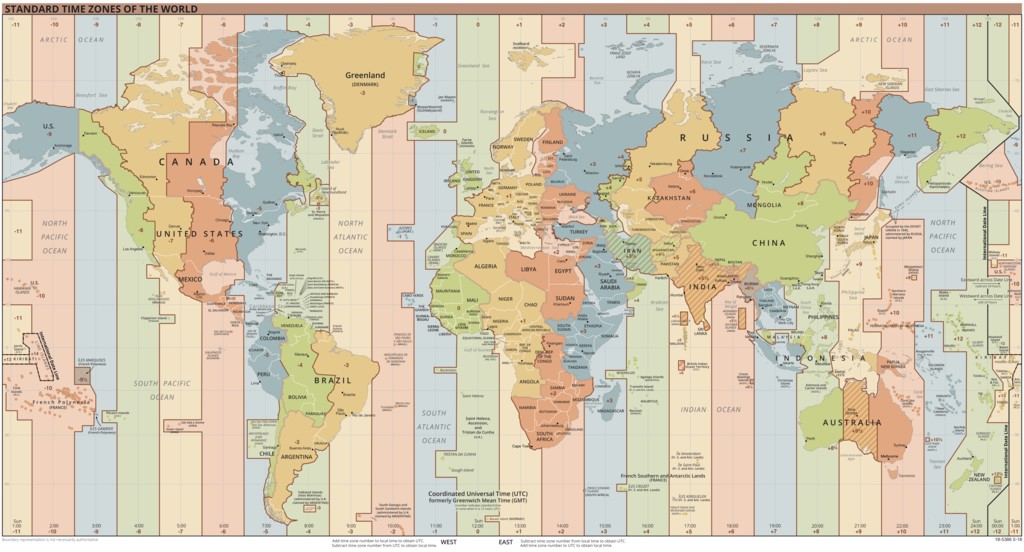What Time is It?
2018-10-05 12:27:54.000 – Taylor Regan, Weather Observer and Research Specialist
After doing some analysis of our historic records, I was pretty interested to find reference to something called “local mean time.” It was a term that didn’t quite line up with what the Observatory (and most folks) use to keep track of time, namely, Standard Time, Daylight Savings Time, and Universal Time (also referred to in some instances as zulu time). Intrigued, I decided to do a little digging, which led me to more questions, and eventually more answers, about why we a) have time zones b) why they exist as they do and c) when they were introduced as they are known now. It’s pretty interesting stuff!
So here’s the scoop: Back in the day, “time zones” were local to the town they referenced. This means, they were driven by the cycle of the sun… “high noon,” sunrise, and sunset often dictated the length of the day. Because of this, the “time of day” at a single moment was different for every location and depended on longitude. Now, for quite a long time, this worked perfectly, transportation was fairly limited and people often didn’t stray too far from their homes and farms. Enter however, the age of the train. It was revolutionary! People could travel long distances seemingly overnight, and it became much more accessible for individuals to begin to commute between towns and cities for work.
This however, created quite a few problems, and required stations to post many different versions of their schedules. Arrival and departure times had to be listed in all the “time zones” that were serviced along a particular route…which got to be quite cumbersome, especially as routes expanded and increased in frequency, and also because local solar time, as it was called, differed by about four minutes per degree of longitude.
On December 1, 1847, British railway companies decided they had had enough, and began using Greenwich Mean Time (GMT). (As an aside, Greenwich Mean Time (GMT) was established in 1675 as a reference for mariners to assist in determining longitude at sea, so that regardless of starting town/location, all longitudinal positions could be determined with reference to one specific point.) This practice quickly took off, and became known as Railway Time. By 1855, 98% of Great Britain’s public clocks were using GMT, and by 1880, it became the official time of Great Britain.
In the United States, however, things were a bit slower to come about. During the mid-1800s, each railroad company used its own “standard time” which was often based on the time of the largest city that was serviced or the location of their headquarters. As such, it was highly unorganized and often difficult to easily get from one location to another, or predict what time you would arrive.
In 1870, Charles F. Dowd proposed four time zones spanning the United States that were eventually centered on the 75th meridian west of Greenwich (in our archived weather records, often denoted 75th meridian time). However, this system was never implemented by the railroads, and instead it was a version proposed by William F. Allen that was accepted and implemented on November 18, 1883, a date referred to as the “Day of Two Noons.” This system had zone borders typically drawn through railroad stations, often located in large cities.
Within a year, 85% of all cities in the U.S. with populations over 10,000 had adopted “standard time.” However, because it was not mandatory, many cities, most notably Detroit, did not adopt this method of timekeeping, and therefore, confusion persisted.
Finally, standardized time zones were officially adopted by the U.S. Congress in the Standard Time Act of March 19, 1918. This formalized the use of time zones as we know them today for the United States (Eastern, Central, Mountain, and Pacific time zones).

Even after the U.S. and several other countries adopted “standardized” time zones, it wasn’t until 1956 that Nepal became the last country to adopt a standard offset at UTC +5:45.
 Figure 2. Current Time Zone Map (Image from wikipedia)
Figure 2. Current Time Zone Map (Image from wikipedia)Of course, there is further intricacy and information out there regarding the fascinating world of time but I just thought I’d share a bit about what I discovered after coming across some interesting notation in our archives.
Bonus Question: Does anyone know why we call Universal Time – Zulu time? Universal Time, or Coordinated Universal Time (UTC) is based at 0° longitude. As such, time at 0° longitude is written with a Z after it, to indicate zero longitude. The phonetic alphabet code for the letter Z is zulu. Overtime, the reference zone came to be known as Zulu Time. (Though it is synonymous with UTC and Greenwhich Mean Time).
Taylor Regan, Weather Observer and Research Specialist
Team Flags Return for Seek the Peak’s 25th Anniversary
Team Flags Return for Seek the Peak's 25th Anniversary By MWOBS Staff Mount Washington Observatory is looking forward to continuing a much-loved tradition for Seek the Peak’s 25th Anniversary: Team flags. In inviting teams
Meet Summer Interns Zakiya, Max and Maddie
Meet Summer Interns Zakiya, Max and Maddie By MWOBS Staff We are excited to welcome six teammates to the summit of Mount Washington this summer! During their internship, these students and graduates will play
Saying Goodbye to the Summit
Saying Goodbye to the Summit By Alexis George After an extraordinary last three years working as a Weather Observer and Meteorologist, I am excited to pursue a different career. As sad I as am




